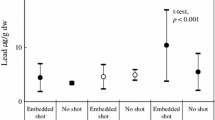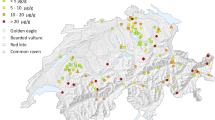Abstract
In May 1999, lead poisoning was diagnosed in a yellow-rumped warbler (Dendroica coronata) and a gray squirrel (Sciurus carolinensis) found at the Federal Law Enforcement Training Center (FLETC), Glynn County, GA, based on detection of 6.2 and 90.0 ppm wet weight (WW) lead in the liver of the warbler and squirrel, respectively. From October 21–26, 1999, 72 wild animals (37 mammals and 35 birds), comprised of 22 different species, were collected from a 24-ha area surrounding the FLETC outdoor firearms shooting range complex to evaluate exposure to lead and other trace elements. Ten animals were used as controls (five mammals and five birds) and were collected from areas 1.5–3 km outside the shooting range area. Kidney and liver tissues were analyzed for lead, zinc, and other trace elements. Bird gizzards and white-tailed deer abomasums were examined grossly and radiographically to detect metallic objects. Twenty-four (33.3%) animals (11 species) had kidney or liver tissue lead levels > 1.00 ppm, and 12 of these (6 species) had levels > 2.00 ppm. Carcasses of one brown-thrasher (Toxostoma rufum) and two white-tailed deer (Odocoileus virginianus) contained lead fragments. Elevated liver tissue levels of zinc (111.0 ppm) were detected in one brown thrasher that also had elevated kidney and liver tissue lead levels. In February 2000, seven yellow-rumped warblers and one solitary vireo (Vireo solitarius) found dead near the FLETC firearms shooting range also were diagnosed with lead poisoning, with liver and kidney tissue lead levels from 1.77–11.6 and 4.55–17.8 ppm WW, respectively. This frequency of elevated tissue lead levels among the animals examined, in combination with confirmed lead toxicosis in both avian and mammalian species at FLETC, indicates significant lead exposure of local wild bird and mammal communities via bullets and fragments in and on the soil surface of the four outdoor ranges. Most FLETC firearms training is being shifted to new baffled ranges (four walls with semiopen top) with bullet recovery capabilities to preclude future deposition of lead in the environment; existing outdoor ranges will be remediated to remove existing lead.
Similar content being viewed by others
Author information
Authors and Affiliations
Additional information
Received: 20 August 2000/Accepted: 22 February 2001
Rights and permissions
About this article
Cite this article
Lewis, L., Poppenga, R., Davidson, W. et al. Lead Toxicosis and Trace Element Levels in Wild Birds and Mammals at a Firearms Training Facility. Arch. Environ. Contam. Toxicol. 41, 208–214 (2001). https://doi.org/10.1007/s002440010239
Issue Date:
DOI: https://doi.org/10.1007/s002440010239




